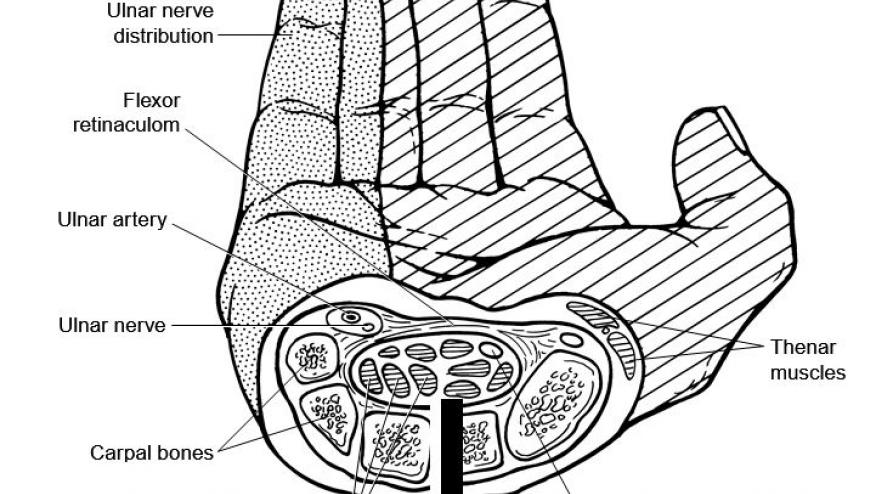Carpal Tunnel Syndrome as a Harbinger of Rheumatoid Arthritis Save

- Previous studies suggested that rheumatoid arthritis is a risk factor for nerve compression syndromes, among which carpal tunnel syndrome is the most common.
- Whether such syndromes may precede overt, diagnosable rheumatoid arthritis was not specifically examined.
- This study found elevated rates of carpal tunnel syndrome in patients diagnosed with rheumatoid arthritis years later, suggesting that it may be a prodromal sign.
Rates of carpal tunnel syndrome (CTS) were significantly greater in patients later diagnosed with rheumatoid arthritis (RA), according to a large, long-running observational study.
Among more than 1,300 people who eventually developed RA, CTS was diagnosed in 13% during the preceding years, compared with just 6% of people without RA, reported Elena Myasoedova, MD, PhD, of the Mayo Clinic in Rochester, Minnesota, for an odds ratio of 2.23 (95% CI 1.69-2.94).
CTS rates were also higher in the RA group after receiving the latter diagnosis, the group noted in Arthritis Care & Research. The cumulative CTS incidence was 9.6% following RA diagnosis, versus 4.5% in the non-RA group (HR 1.78, 95% CI 1.38-2.30).
These data indicate that CTS "can be an early underrecognized clinical feature of RA disease continuum, i.e., 'at risk of RA' state," they wrote.
"These findings suggest the need for increased awareness of heightened risk of RA in patients with persistent CTS and consideration for rheumatology referral in patients at risk of RA with CTS that is not explained by traditional risk factors," they added.
RA involves systemic inflammation, and many studies have established this as a risk factor for CTS. RA patients are known to experience CTS at rates higher than in the general population. But whether CTS might precede RA, and by how long, has not been studied specifically until now.
Myasoedova and colleagues drew on the long-running Rochester Epidemiology Project, with participation from most healthcare institutions in Olmsted County, Minnesota, the region surrounding the Mayo Clinic's headquarters. They searched for participants with RA diagnoses and matched them 1:1 to non-RA patients of the same age and sex; for the non-RA patients, an "index date" was chosen to correspond with their matched RA patient's date of RA diagnosis. Both CTS and RA diagnoses were based on billing codes in their electronic health records. In all, 1,335 RA patients were included along with 1,331 non-RA controls.
Factors taken into account during statistical modeling included age, sex, calendar year, smoking status, and presence of obesity, type 2 diabetes, and hypothyroidism. Median follow-up was 12.8 years for the RA patients and 13.8 among controls. Mean participant age was 56, and just under 70% were women. Some 63% of the RA group were positive for standard serum biomarkers such as rheumatoid factor.
One provocative finding was that CTS diagnoses were mostly made at least 2 years before RA diagnosis or the corresponding index date: in the RA group, 112 of the 179 total occurred in this period. There was no noticeable difference in CTS rates between RA and non-RA patients until 5 years prior, and then the CTS diagnostic trajectories diverged.
Also, Myasoedova's group found that seronegative RA patients appeared somewhat more likely to experience CTS before RA diagnosis than those carrying the biomarkers (HR 1.36, 95% CI 0.99-1.88). Obesity was also linked to increased CTS risk (HR 1.42, 95% CI 1.02-1.99).
Limitations to the study included that Olmsted County's demographics differ somewhat from the U.S. in general, and it relied on administrative data that could have been erroneous. Also, onset of RA and CTS likely preceded their formal diagnosis to an unknown degree; thus, the relationship between incident RA and CTS might differ from the current results if point of onset was considered in place of diagnosis.
"Future studies involving a larger, more diverse population would help our understanding of the relationship between CTS and RA and could inform risk stratification and earlier treatment for patients," the researchers wrote.
Source Reference: George RJ, et al "Carpal tunnel syndrome (CTS) is an early underrecognized feature of rheumatoid arthritis (RA): a population-based study of CTS occurrence before and after RA incidence" Arthritis Care Res 2025; DOI: 10.1002/acr.25566.










If you are a health practitioner, you may Login/Register to comment.
Due to the nature of these comment forums, only health practitioners are allowed to comment at this time.